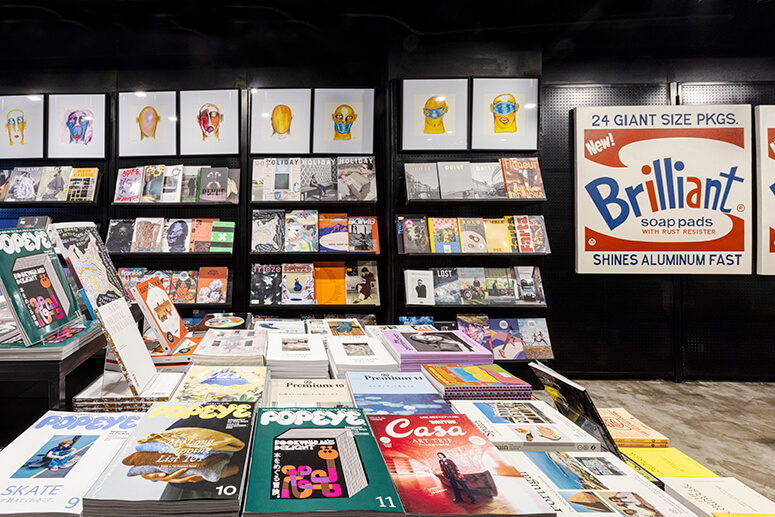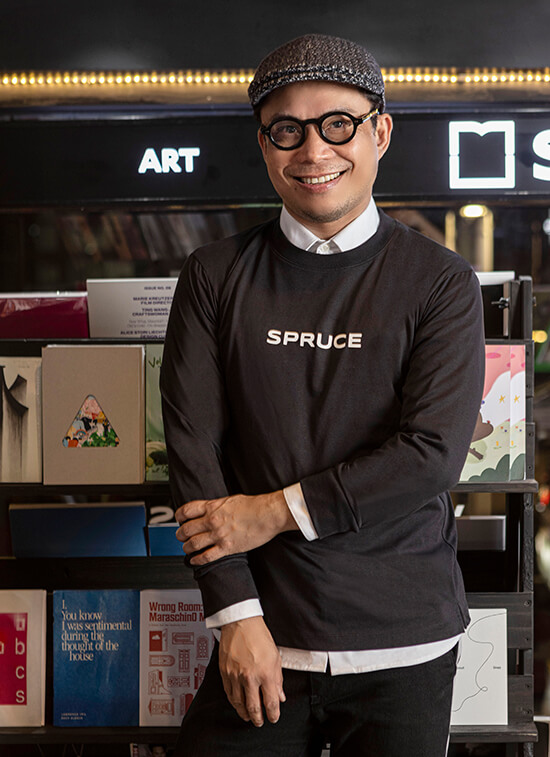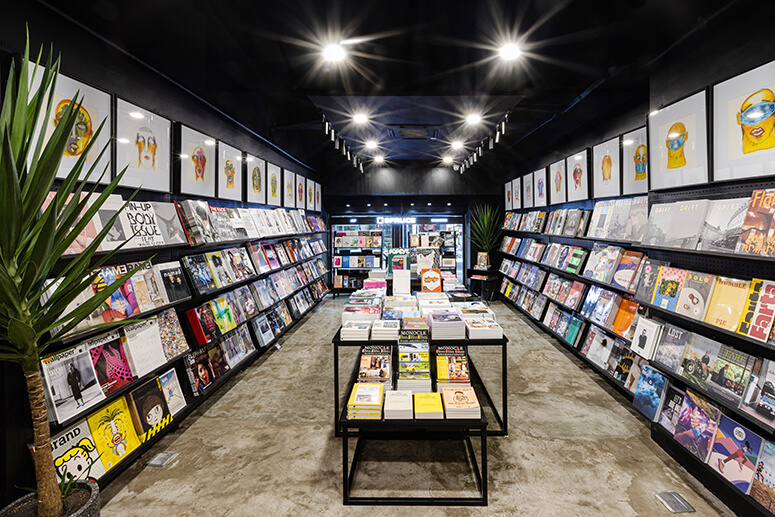For Spruce Gallery, print was never dead
The birth of the digital age catalyzed the print media industry to retaliate and go online. But even then, print was never dead. Spruce Gallery, a rare gem in Manila that sells print magazines and art pieces, would tell you the same story. As a matter of fact, Spruce is a testament that print’s relevance in today’s digital society is far from perishing.
Situated in Ortigas, the varying titles of glossy and matte publications—a combination of renowned and niche—are laid out straight, much like how visual art pieces are perfectly curated in a gallery, yet most copies are unsealed and ready for browsing. There is a Monocle radio placed at a corner and co-owner Ric Gindap is vibrating with excitement when he welcomes me wearing a black shirt that says “Spruce” and a flat cap.
Ric works at a top branding agency called Design For Tomorrow and is one of the founders of Spruce Gallery. “This is a passion project,” he says of operating the print and art gallery store. Even before the birth of Spruce, Ric has always loved print. At his home, he has four panels of ceiling-to-floor shelves of magazines and books.

When traveling abroad, he purchases copies of such print media together with his business partner Bonnapart Galeng. They both had gone to magCulture in London and Do You Read Me in Berlin and thought, “How come we don’t have this in Manila?”
“(Spruce Gallery is) a reflection of how we love print,” Ric says. “You can’t just say you love it and not do something about it.”
In the Philippines, there is a massive decline in magazines at bookstores. Although monographs, literature, and manga are still available, newsstands are almost often empty. There are some local titles, but shops have eased out magazines completely. Ric sees it as an opportunity and another factor that contributes to running Spruce Gallery, but their business is different. Its main goal is to jumpstart a conversation with people who love magazines.
He reveals that their brand name is a French term, but its roots come from Prussia, a state abundant in the timber used to make paper and frame art. “Since we do (have) art and magazines, it is a perfect name because it can navigate both,” he explains. “In English, it means improving yourself.”
Similarly, Spruce Gallery’s logo looks like a frame and a window, which Ric shares stems from their mission to transport their audience to a different world. “On top is a magazine, (while) on the bottom is an art frame. It’s very simple, but art and magazines are that window.”
Ric notes the importance of print despite the trend of digital and emerging media. “Magazines take time to produce,” he argues. There is a thorough process involved in it, “(from the) planning stage, theme development, commissioning of stories, shooting for the visuals, until printing and distributing.” It’s why he believes the stories worthy of a deep dive are in print. It is a product of extensive work and research. “Magazines are different because every decision takes time.”
With print, “people linger,” Ric says. “It’s something that you can’t swipe off.” The idea of undivided attention, he thinks, is something print offers that digital can’t.
However, he believes that digital is not an enemy. “We need digital for speed, but if you want undivided attention and pure pleasurable experience, you sit in a comfortable chair and nothing comes between you and the printed page.”

He supposes people are not reading due to disinterest, but because “there are less spaces conducive for reading.” As such, Spruce Gallery believes print stores can be where people build a connection with a title and perhaps other readers.
At their store, each title can be opened and skimmed by customers because they didn’t want the traditional grab-and-go experience. There are tables and chairs for people to situate themselves, look through the material, and possibly find something inside to resonate with. “Before you purchase, you already form an attraction to the content,” Ric says.
With print, ‘people linger,’ Ric says. ‘It’s something that you can’t swipe off.’
The gallery also holds events at the store. “We wanted to provide a corner for people who are not just interested in print, but also in ideas,” Ric adds. They recently did a reading for POPEYE, a Tokyo magazine for city boys. “We connect a title with a specific subculture, and that (becomes) the breeding ground for all the conversations we’re having here.”
There are copies of Kinfolk, Dazed, The London Review, The New Yorker, and other international titles that are hard to source in the country, which Ric calls “a gateway to discover.” But the gallery is also a place that champions local creatives. “We want Spruce (to be) a space of pride for local voices, (who) are never lacking creativity and originality.“
Near a window, a rack is filled with a Filipino zine titled I Live! about the joys, victories, and euphoria of queerness. It is produced by Don’t Tell Nanay, a community of Filipino artists. Spruce doesn't put consignment fees or get a cut from the sales; all proceeds go to independent producers.
Ric reveals it is mostly young Filipinos who buy from their store. Teenagers and recent graduates sell out their copies of The Paris Review and Monocle. It made him realize that there is no truth to the notion that Gen Zs are not readers. “Young people would love to read if you give them quality reads.” He deduces that if the Philippines provides support for independent Filipino titlestackling different interests and cultures, as well as physical stores for them, many more Filipinos would be attracted to read.
“It really is a testament that print was never dead,” he reports. “A lot of people, (including) publishers and retailers, just gave up on it. It was never dead.”
While it’s the economy that mainly contributed to titles going digital, Ric still believes in the power of print. After all, 16 months after opening, Spruce Gallery is still alive and thriving. “We’re not going to be as big as other bookstores,” he cautiously admits, “but we have carved our own little corner where magazines still have a valid reason to stay and also connect with younger audiences.”

The overwhelming amount of information handed by digital platforms to their users necessitates the return of print media. “We need print because we are bombarded with so much intrusions (online). We need to carve out a moment of quiet where we can decompress and just be lost in a world of wonder and beauty in print,” Ric says.
“A well-written piece with a different perspective will convert your prejudices and your long-held conventional thoughts,” he adds. “That’s the beauty of print. It sharpens your ability to think.”
“People are getting sick of the online noise,” Ric says. “You know how it is in society: dissatisfaction and the lack of something that matters is the root of every movement.” This prompts Ric to believe that “the next generation of print is in the trajectory that (will) remind you of your own feelings, bring you to your own sensations, and push you to think.”


